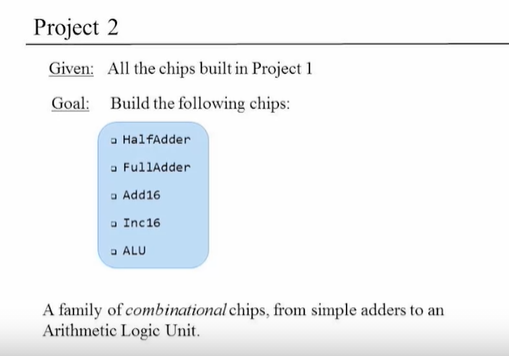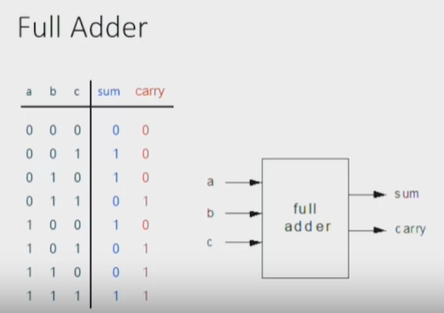Boolean Arithmetic and the ALU
写HDL时可能出现的问题
本周的ALU代码部分比较复杂,也需要不少技巧性。我在犯错后,也在论坛上浏览不少,总结一下容易犯的错误。
- 不知道”多重输出“(Multiple Outputs),也就是可以有多个out,输出给不同的寄存器,而且这些寄存器往往只能使用一次。似乎存储结果的out,是不可以被使用的。
- ”子数据线“(sub-busing)下标问题,常见的有两个,一是中间变量不能使用sub-busing,也就是说,不能使用
something[a..b]这个格式;第二就是这个子数据线只能放在左边,不能在右边。
Sub-bussing (indexing) internal pins: Is not permitted. The only bus-pins that can be indexed are the input and output pins of the implemented chip, or the input and output pins of its chip-parts. However, there is a workaround for sub-bussing internal bus-pins. To motivate the workaround, here is an example that doesn’t work: ```verilog CHIP Foo {
IN in[16];
OUT out;
PARTS:
Not16 (in=in, out=notIn);
Or8Way (in=notIn[4..11], out=out); // Error: internal bus cannot be indexed.
}
> Possible fix, using the workaround:> ```verilogNot16 (in=in, out[4..11]=notIn);Or8Way (in=notIn, out=out); // Works!
作业顺序

半加器 HalfAdder
半加器的真值表
| a | b | sum | carry |
|---|---|---|---|
| 0 | 0 | 0 | 0 |
| 0 | 1 | 1 | 0 |
| 1 | 0 | 1 | 0 |
| 1 | 1 | 0 | 1 |
观察真值表,可以得出
sum = a xor b和carry = a and b
全加器 FullAdder
全加器真值表

// This file is part of www.nand2tetris.org
// and the book "The Elements of Computing Systems"
// by Nisan and Schocken, MIT Press.
// File name: projects/02/FullAdder.hdl
/**
* Computes the sum of three bits.
*/
CHIP FullAdder {
IN a, b, c; // 1-bit inputs
OUT sum, // Right bit of a + b + c
carry; // Left bit of a + b + c
PARTS:
// Put you code here:
HalfAdder(a=a, b=b, sum=lowbit, carry=tmp1);
HalfAdder(a=lowbit, b=c, sum=sum, carry=tmp2);
Or(a=tmp1, b=tmp2, out=carry);
}
16位全加器 Add16
我不太清楚,中间变量只能使用一次?
FullAdder(a=a[1], b=b[1], c=tmp, sum=out[1], carry=tmp1);的写法就出错?
// This file is part of www.nand2tetris.org
// and the book "The Elements of Computing Systems"
// by Nisan and Schocken, MIT Press.
// File name: projects/02/Adder16.hdl
/**
* Adds two 16-bit values.
* The most significant carry bit is ignored.
*/
CHIP Add16 {
IN a[16], b[16];
OUT out[16];
PARTS:
// Put you code here:
HalfAdder(a=a[0], b=b[0], sum=out[0], carry=tmp);
// halfAdder(a=a[0], b=[0], c=false, sum=out[0], carry=tmp);
FullAdder(a=a[1], b=b[1], c=tmp, sum=out[1], carry=tmp1);
FullAdder(a=a[2], b=b[2], c=tmp1, sum=out[2], carry=tmp2);
FullAdder(a=a[3], b=b[3], c=tmp2, sum=out[3], carry=tmp3);
FullAdder(a=a[4], b=b[4], c=tmp3, sum=out[4], carry=tmp4);
FullAdder(a=a[5], b=b[5], c=tmp4, sum=out[5], carry=tmp5);
FullAdder(a=a[6], b=b[6], c=tmp5, sum=out[6], carry=tmp6);
FullAdder(a=a[7], b=b[7], c=tmp6, sum=out[7], carry=tmp7);
FullAdder(a=a[8], b=b[8], c=tmp7, sum=out[8], carry=tmp8);
FullAdder(a=a[9], b=b[9], c=tmp8, sum=out[9], carry=tmp9);
FullAdder(a=a[10], b=b[10], c=tmp9, sum=out[10], carry=tmp10);
FullAdder(a=a[11], b=b[11], c=tmp10, sum=out[11], carry=tmp11);
FullAdder(a=a[12], b=b[12], c=tmp11, sum=out[12], carry=tmp12);
FullAdder(a=a[13], b=b[13], c=tmp12, sum=out[13], carry=tmp13);
FullAdder(a=a[14], b=b[14], c=tmp13, sum=out[14], carry=tmp14);
FullAdder(a=a[15], b=b[15], c=tmp14, sum=out[15], carry=tmp15);
}
16位增量器 Inc16
我也没接触过数字电路,也不知道是不是对应这个名字。
原来输入的“数组”,可以根据下标进行拆分。
// This file is part of www.nand2tetris.org
// and the book "The Elements of Computing Systems"
// by Nisan and Schocken, MIT Press.
// File name: projects/02/Inc16.hdl
/**
* 16-bit incrementer:
* out = in + 1 (arithmetic addition)
*/
CHIP Inc16 {
IN in[16];
OUT out[16];
PARTS:
// Put you code here:
Add16(a=in, b[1..15]=false, b[0]=true, out=out);
}
写完这个,自己测试,没太看懂😥过程,发现输出闪了好多次,姑且提交测试一下:通过了。
但是,最后一个ALU分值太高。
算术逻辑单元 ALU
主要就是思考如何实现if,使用Mux选择器,进行选择。
说明:ALU占据的分值最大,不提交最多只能得66分,并不能通过(75分)。
设计逻辑不算难,特别是许多东西能用C语言想到,就考虑如何转化成HDL。
我的错误就在下面标注的两行:
mark1:没有注意到这个“多重输出”,我在后面想直接使用out作为下一步的计算,但是总是提示
error massage: can’t connect gate’s output pin to part
但不幸的是,我的屏幕太小了,刚好看不到下面的错误信息,并且这个软件有个致命缺陷!你缩小它,仅仅是调小了窗口,内容不变小,因此也看不到下面!
最后我通过把任务栏移动到左边,勉强看到一点红色的错误信息,还需要把光标放在上面,通过光标的小窗口才看得到。
mark2:这个错误可能是重写时,无意犯的错误。也就导致了没有通过案例,test会在输出的那一行停下来,仔细对比一下正确输出和自己的输出,看看哪里可能出现问题。
我的错误是,mark2处,b参数填错了,错误的写成了false。
And16(a=sign, b=false, out[0..7]=out1, out[8..15]=out2);
应当注意,如果想要选取一部分,需要与全1进行与运算。
Multiple Outputs
Sometimes you need more than one sub-bus connected to the output of a chip-part. Simply add more than one
out=connection to the chip-part definition.CHIP Foo { IN in[16]; OUT out[8]; PARTS: Not16 (in=in, out[0..7]=low8, out[8..15]=high8); Something8 (a=low8, b=high8, out=out); }This also works if you want to use an output of a chip in further computations.
CHIP Foo { IN a, b, c; OUT out1, out2; PARTS: Something (a=a, b=b, out=x, out=out1); Whatever (a=x, b=c, out=out2); }
// This file is part of www.nand2tetris.org
// and the book "The Elements of Computing Systems"
// by Nisan and Schocken, MIT Press.
// File name: projects/02/ALU.hdl
/**
* The ALU (Arithmetic Logic Unit).
* Computes one of the following functions:
* x+y, x-y, y-x, 0, 1, -1, x, y, -x, -y, !x, !y,
* x+1, y+1, x-1, y-1, x&y, x|y on two 16-bit inputs,
* according to 6 input bits denoted zx,nx,zy,ny,f,no.
* In addition, the ALU computes two 1-bit outputs:
* if the ALU output == 0, zr is set to 1; otherwise zr is set to 0;
* if the ALU output < 0, ng is set to 1; otherwise ng is set to 0.
*/
// Implementation: the ALU logic manipulates the x and y inputs
// and operates on the resulting values, as follows:
// if (zx == 1) set x = 0 // 16-bit constant
// if (nx == 1) set x = !x // bitwise not
// if (zy == 1) set y = 0 // 16-bit constant
// if (ny == 1) set y = !y // bitwise not
// if (f == 1) set out = x + y // integer 2's complement addition
// if (f == 0) set out = x & y // bitwise and
// if (no == 1) set out = !out // bitwise not
// if (out == 0) set zr = 1
// if (out < 0) set ng = 1
CHIP ALU {
IN
x[16], y[16], // 16-bit inputs
zx, // zero the x input?
nx, // negate the x input?
zy, // zero the y input?
ny, // negate the y input?
f, // compute out = x + y (if 1) or x & y (if 0)
no; // negate the out output?
OUT
out[16], // 16-bit output
zr, // 1 if (out == 0), 0 otherwise
ng; // 1 if (out < 0), 0 otherwise
PARTS:
// Put you code here:
Mux16(a=x, b=false, sel=zx, out=x1);
Not16(in=x1, out=notx);
Mux16(a=x1, b=notx, sel=nx, out=x2);
Mux16(a=y, b=false, sel=zy, out=y1);
Not16(in=y1, out=noty);
Mux16(a=y1, b=noty, sel=ny, out=y2);
Add16(a=x2, b=y2, out=xaddy);
And16(a=x2, b=y2, out=xandy);
Mux16(a=xandy, b=xaddy, sel=f, out=out0);
Not16(in=out0, out=notout);
Mux16(a=out0, b=notout, sel=no, out=out, out=sign, out[15]=flag); //mark1
/*
notes: the out can't be used
error massage: can't connect gate's output pin to part
*/
And16(a=sign, b=true, out[0..7]=out1, out[8..15]=out2); //mark2
Or8Way(in=out1, out=st1);
Or8Way(in=out2, out=st2);
Or(a=st1, b=st2, out=st);
Mux(a=true, b=false, sel=st, out=zr);
Mux(a=false, b=true, sel=flag, out=ng);
}
作业提交
总结
许多错误,巧就巧在撞在了一起。
屏幕小,看不到错误信息,之前都是瞎调,刚好比较容易也没当回事,这次ALU错误猜了好久耽误了时间。
外加不熟悉HDL,很多写法也不知道是否规范。索性最后还是顺利解决了。
还有一个问题,就是对昨天写的很多东西,光看名字确实容易忘、混淆,需要去看一下API和作用。


